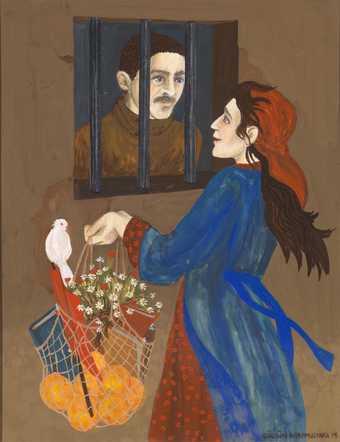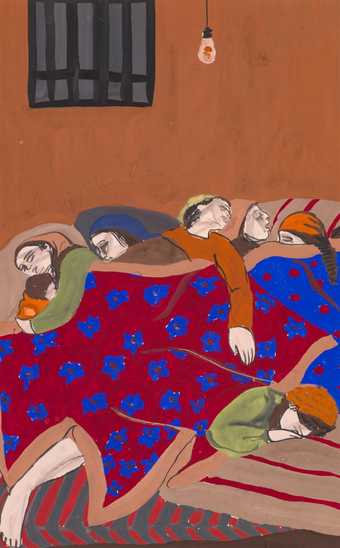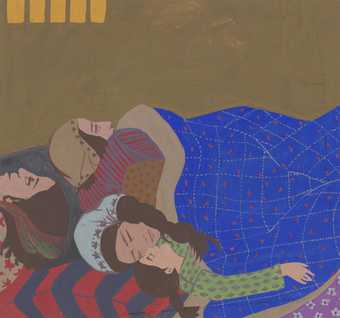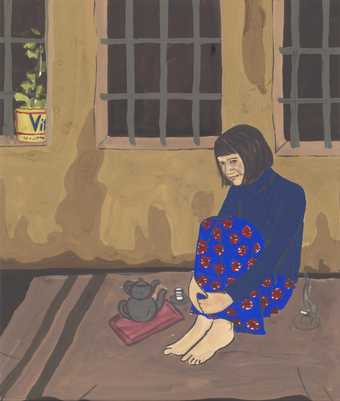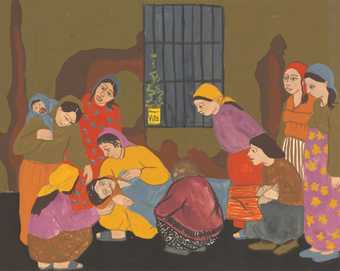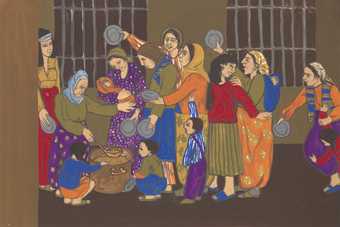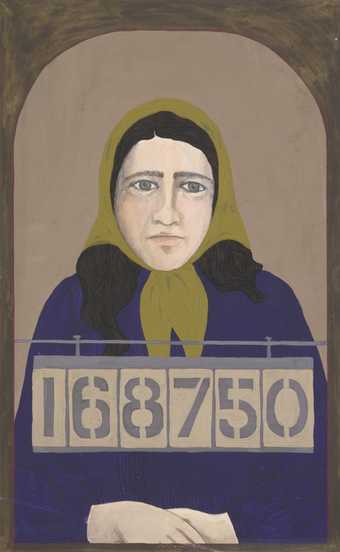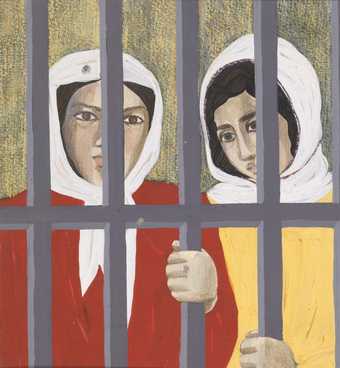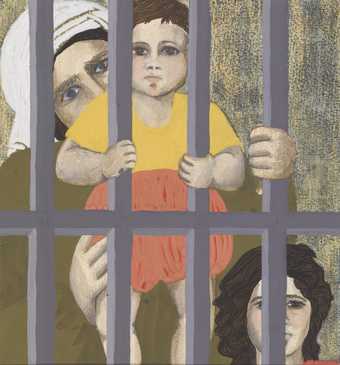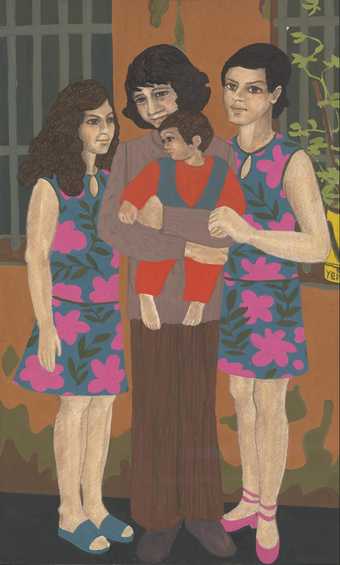
Not on display
- Artist
- Edward Allington 1951–2017
- Medium
- Ink, watercolour, acrylic paint, crayon and graphite on ledger paper
- Dimensions
- Support: 600 × 870 mm
- Collection
- Presented by Peter Fleissig through Tate Americas Foundation 2018
On long term loan - Reference
- L04209
Summary
This is a landscape format painting in ink and emulsion on paper. The ground is made up of twenty-four sheets of found ledger paper that have been pasted together and painted over. It depicts a view from above of a group of nine sculptural objects – the ideal standard forms of the title – arranged in a grid on the floor of a schematically depicted room. The floor is coloured brown and the walls, like the sculptures, are painted white. The forms are delineated in black ink and each casts an individual shadow from a light source that does not appear to be uniform.
Allington was identified with the emergence of a new approach to sculpture in Britain at the end of the 1970s and early 1980s. This New British Sculpture had a dual concern for object and image (as seen in one early exhibition that included Allington’s work, Objects and Sculpture at the Arnolfini Gallery, Bristol and Institute of Contemporary Art, London in 1981). These concerns allied it to similar contemporaneous developments in painting that were often described by the term ‘new image painting’. Allington’s work – like that of many of his contemporaries – is characterised by a use of cheap found materials that connect with a contemporary everyday life. For instance, his sculpture Oblivion Penetrated 1982 (Tate T06895) consists of a gilded cornucopia expelling plastic bananas and bunches of grapes. A work such as this describes a link between the real and the fake, raising issues around reproducibility and value.
However, at the root of Allington’s work is his engagement with a clash of traditions and philosophies between classical forms (or ideals) and the everyday life of the street. Thus the sculpture Ideal Standard Forms 1980 (Tate T05214) is a group of moulds – rather than finished forms – that locate a classical Platonic ‘ideal’ in something ‘standard’; the shift from original to copy itself implies that there is no such thing as an original, only restoration, re-making and reproduction. The drawing Ideal Standard Forms 1981 is related to this sculpture and extends such ideas, though it was not a preparatory drawing for the sculpture, having been made the year after. It was also a very early example of the procedure that Allington would follow throughout the rest of his career, of making drawings on surfaces glued together from found waste papers – ledgers, order books, graph paper and the like. The images for his drawings offer an alternative view of sculpture from three to two dimensions, often projected into a room-like setting, as here.
The critic Stuart Morgan observed of such works:
By painting walls white the papers, arranged so that their repetitive design detracted from their previous use, became the floor of an imaginary museum, identified in Allington’s mind with the ‘Platonic’ realm of the imagination, in which perfection was possible … Following Allington’s ideas as they shift from two to three dimensions involves a movement from illusion to disillusion, from a state in which mundane considerations hold sway to actuality regarded as a fallen state.
(Stuart Morgan, Edward Allington, Drawings Towards Sculpture, exhibition catalogue, Institute of Contemporary Arts, London/Lisson Gallery, London 1983, unpaginated.)
Further reading
Edward Allington, In Pursuit of Savage Luxury, exhibition catalogue, Midland Group, Nottingham 1984.
Edward Allington: New Sculpture, exhibition catalogue, Riverside Studios, London 1985.
Edward Allington, exhibition catalogue, Cornerhouse, Manchester 1993.
Andrew Wilson
April 2018
Does this text contain inaccurate information or language that you feel we should improve or change? We would like to hear from you.
You might like
-
Edward Allington Seated in Darkness
1987 -
John Golding Drawing 85/8
1985 -
Gulsun Karamustafa Prison Paintings 1
1978 -
Gulsun Karamustafa Prison Paintings 2
1978 -
Gulsun Karamustafa Prison Paintings 5
1972 -
Gulsun Karamustafa Prison Paintings 6
1972 -
Gulsun Karamustafa Prison Paintings 8
1972 -
Gulsun Karamustafa Prison Paintings 9
1972 -
Gulsun Karamustafa Prison Paintings 10
1972 -
Gulsun Karamustafa Prison Paintings 11
1972 -
Gulsun Karamustafa Prison Paintings 14
1972 -
Gulsun Karamustafa Prison Paintings 15
1972 -
Gulsun Karamustafa Prison Paintings 16
1972 -
Gulsun Karamustafa Prison Paintings 17
1972




